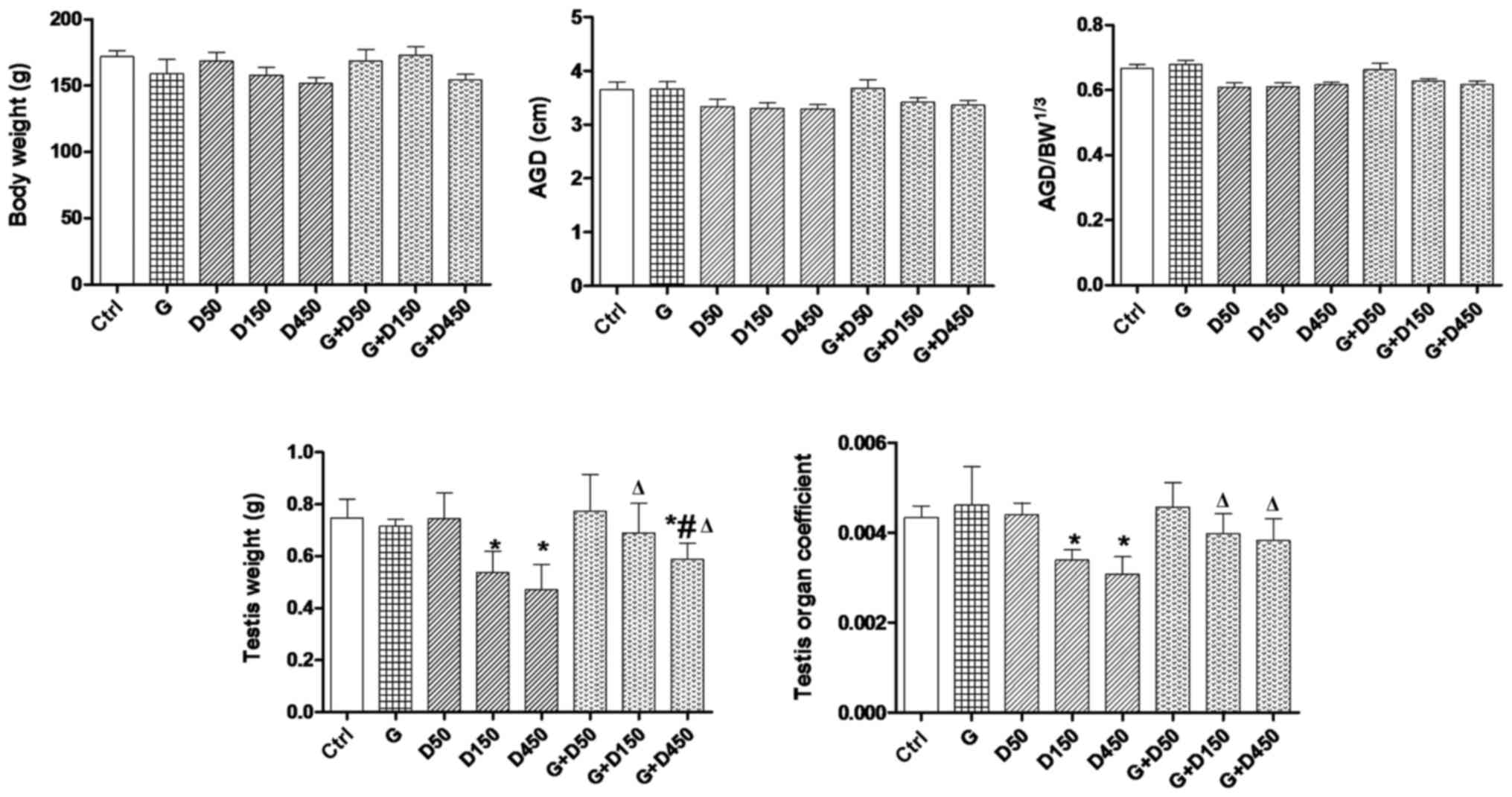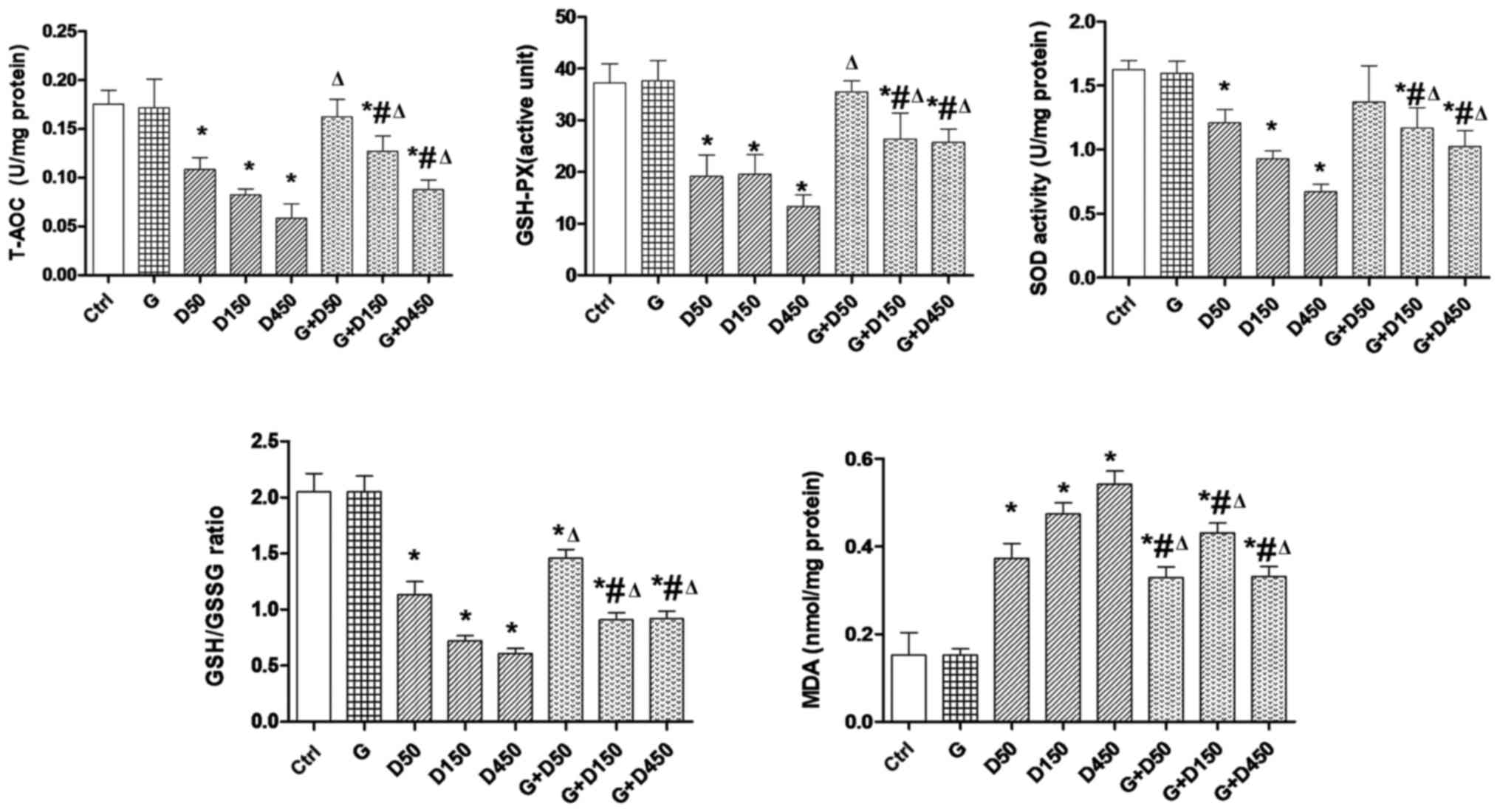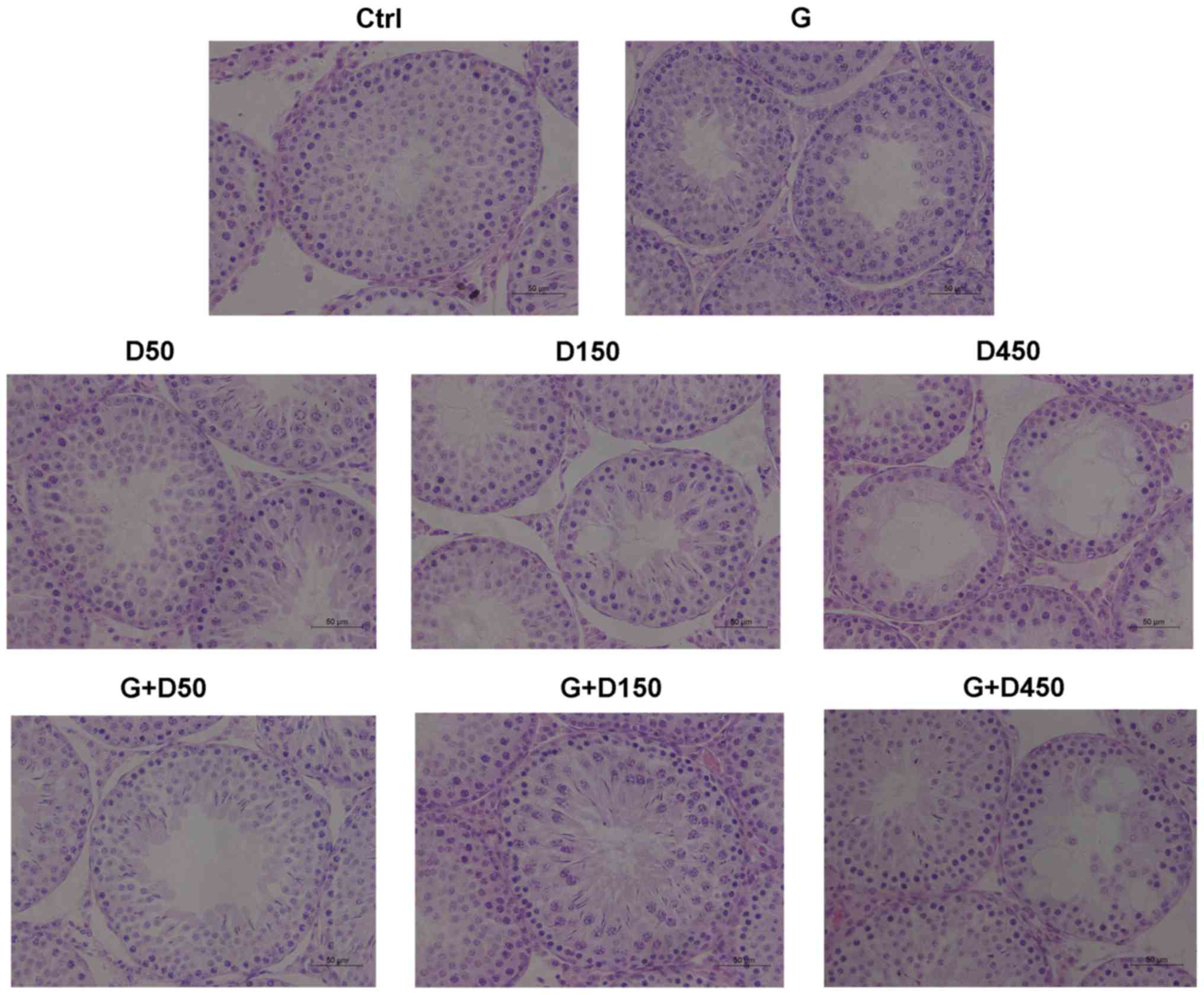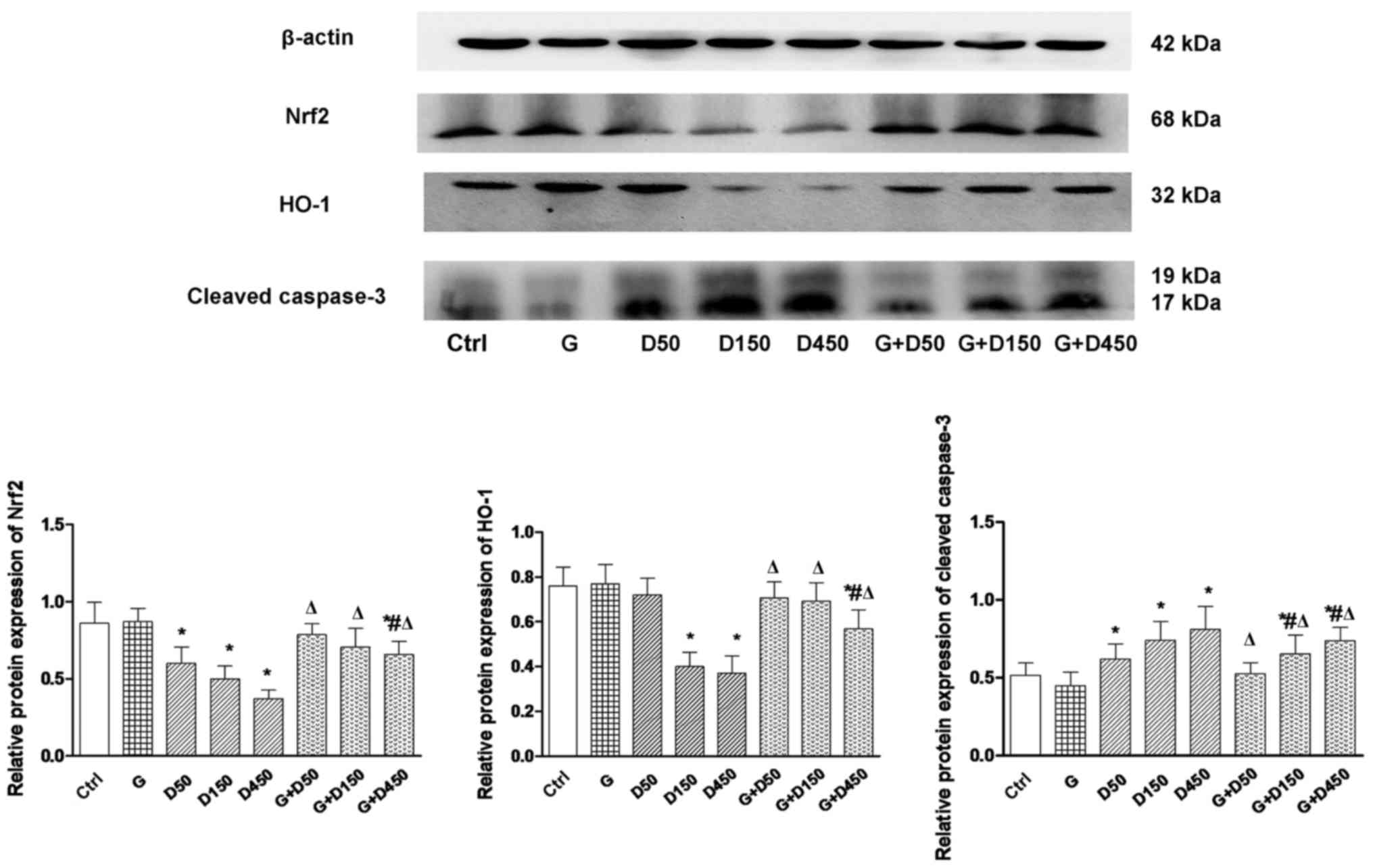|
1
|
Nassouri AS, Archambeaud F and Desailloud
R: Endocrine disruptors: Echoes of congress of endocrinology in
2012. Ann Endocrinol (Paris). 73(Suppl 1): S36–S44. 2012.In French.
View Article : Google Scholar
|
|
2
|
Silins I and Högberg J: Combined toxic
exposures and human health: Biomarkers of exposure and effect. Int
J Environ Res Public Health. 8:629–647. 2011. View Article : Google Scholar : PubMed/NCBI
|
|
3
|
Spurgeon DJ, Jones OA, Dorne JL, Svendsen
C, Swain S and Stürzenbaum SR: Systems toxicology approaches for
understanding the joint effects of environmental chemical mixtures.
Sci Total Environ. 408:3725–3734. 2010. View Article : Google Scholar : PubMed/NCBI
|
|
4
|
Aksglaede L, Juul A, Leffers H, Skakkebaek
NE and Andersson AM: The sensitivity of the child to sex steroids:
Possible impact of exogenous estrogens. Hum Reprod Update.
12:341–349. 2006. View Article : Google Scholar : PubMed/NCBI
|
|
5
|
Perobelli JE: The male peripubertal phase
as a developmental window for reproductive toxicology studies. Curr
Pharm Des. 20:5398–5415. 2014. View Article : Google Scholar : PubMed/NCBI
|
|
6
|
Kamrin MA: Phthalate risks, phthalate
regulation, and public health: A review. J Toxicol Environ Health B
Crit Rev. 12:157–174. 2009. View Article : Google Scholar : PubMed/NCBI
|
|
7
|
Erkekoglu P, Rachidi W, Yuzugullu OG,
Giray B, Favier A, Ozturk M and Hincal F: Evaluation of
cytotoxicity and oxidative DNA damaging effects of
di(2-ethylhexyl)-phthalate (DEHP) and mono(2-ethylhexyl)-phthalate
(MEHP) on MA-10 Leydig cells and protection by selenium. Toxicol
Appl Pharmacol. 248:52–62. 2010. View Article : Google Scholar : PubMed/NCBI
|
|
8
|
Culty M, Thuillier R, Li W, Wang Y,
Martinez-Arguelles DB, Benjamin CG, Triantafilou KM, Zirkin BR and
Papadopoulos V: In utero exposure to di-(2-ethylhexyl) phthalate
exerts both short-term and long-lasting suppressive effects on
testosterone production in the rat. Biol Reprod. 78:1018–1028.
2008. View Article : Google Scholar : PubMed/NCBI
|
|
9
|
O'Brien ML, Spear BT and Glauert HP: Role
of oxidative stress in peroxisome proliferator-mediated
carcinogenesis. Crit Rev Toxicol. 35:61–88. 2005. View Article : Google Scholar : PubMed/NCBI
|
|
10
|
Erkekoglu P, Giray B, Rachidi W,
Hininger-Favier I, Roussel AM, Favier A and Hincal F: Effects of
di(2-ethylhexyl)phthalate on testicular oxidant/antioxidant status
in selenium-deficient and selenium-supplemented rats. Environ
Toxicol. 29:98–107. 2014. View Article : Google Scholar
|
|
11
|
Kim S, Kang S, Lee G, Lee S, Jo A, Kwak K,
Kim D, Koh D, Kho YL, Kim S, et al: Urinary phthalate metabolites
among elementary school children of Korea: Sources, risks, and
their association with oxidative stress marker. Sci Total Environ.
472:49–55. 2014. View Article : Google Scholar
|
|
12
|
Duncan AM, Phipps WR and Kurzer MS:
Phyto-oestrogens. Best Pract Res Clin Endocrinol Metab. 17:253–271.
2003. View Article : Google Scholar : PubMed/NCBI
|
|
13
|
Kumi-Diaka J, Nguyen V and Butler A:
Cytotoxic potential of the phytochemical genistein isoflavone
(4′,5′,7-trihydroxyisoflavone) and certain environmental chemical
compounds on testicular cells. Biol Cell. 91:515–523. 1999.
View Article : Google Scholar : PubMed/NCBI
|
|
14
|
Gong DK, Liu BH and Tan XH: Genistein
prevents cadmium-induced neurotoxic effects through its antioxidant
mechanisms. Drug Res (Stuttg). 65:65–69. 2015.
|
|
15
|
Georgetti SR, Casagrande R, Vicentini FT,
Baracat MM, Verri WA Jr and Fonseca MJ: Protective effect of
fermented soybean dried extracts against TPA-induced oxidative
stress in hairless mice skin. BioMed Res Int. 2013:3406262013.
View Article : Google Scholar : PubMed/NCBI
|
|
16
|
Utrera M and Estévez M: Impact of trolox,
quercetin, genistein and gallic acid on the oxidative damage to
myofibrillar proteins: The carbonylation pathway. Food Chem.
141:4000–4009. 2013. View Article : Google Scholar : PubMed/NCBI
|
|
17
|
Roberts D, Veeramachaneni DN, Schlaff WD
and Awoniyi CA: Effects of chronic dietary exposure to genistein, a
phytoestrogen, during various stages of development on reproductive
hormones and spermatogenesis in rats. Endocrine. 13:281–286. 2000.
View Article : Google Scholar
|
|
18
|
Christiansen S, Boberg J, Axelstad M,
Dalgaard M, Vinggaard AM, Metzdorff SB and Hass U: Low-dose
perinatal exposure to di(2-ethylhexyl) phthalate induces
anti-androgenic effects in male rats. Reprod Toxicol. 30:313–321.
2010. View Article : Google Scholar : PubMed/NCBI
|
|
19
|
Kma L: Plant extracts and plant-derived
compounds: Promising players in a countermeasure strategy against
radiological exposure. Asian Pac J Cancer Prev. 15:2405–2425. 2014.
View Article : Google Scholar : PubMed/NCBI
|
|
20
|
Jones S, Boisvert A, Francois S, Zhang L
and Culty M: In utero exposure to di-(2-ethylhexyl) phthalate
induces testicular effects in neonatal rats that are antagonized by
genistein cotreatment. Biol Reprod. 93:922015. View Article : Google Scholar : PubMed/NCBI
|
|
21
|
Aitken RJ, Smith TB, Jobling MS, Baker MA
and De Iuliis GN: Oxidative stress and male reproductive health.
Asian J Androl. 16:31–38. 2014. View Article : Google Scholar :
|
|
22
|
Michael McClain R, Wolz E, Davidovich A,
Pfannkuch F, Edwards JA and Bausch J: Acute, subchronic and chronic
safety studies with genistein in rats. Food Chem Toxicol. 44:56–80.
2006. View Article : Google Scholar
|
|
23
|
Weber KS, Setchell KD, Stocco DM and
Lephart ED: Dietary soy-phytoestrogens decrease testosterone levels
and prostate weight without altering LH, prostate 5alpha-reductase
or testicular steroidogenic acute regulatory peptide levels in
adult male Sprague-Dawley rats. J Endocrinol. 170:591–599. 2001.
View Article : Google Scholar : PubMed/NCBI
|
|
24
|
Adlercreutz H, Markkanen H and Watanabe S:
Plasma concentrations of phyto-oestrogens in Japanese men. Lancet.
342:1209–1210. 1993. View Article : Google Scholar : PubMed/NCBI
|
|
25
|
Vandenberg LN, Colborn T, Hayes TB,
Heindel JJ, Jacobs DR Jr, Lee DH, Shioda T, Soto AM, vom Saal FS,
Welshons WV, et al: Hormones and endocrine-disrupting chemicals:
Low-dose effects and nonmonotonic dose responses. Endocr Rev.
33:378–455. 2012. View Article : Google Scholar : PubMed/NCBI
|
|
26
|
Wei M, Wu Y, Chen D and Gu Y: Changes of
free radicals and digestive enzymes in saliva in cases with
deficiency in spleen-yin syndrome. J Biomed Res. 24:250–255. 2010.
View Article : Google Scholar : PubMed/NCBI
|
|
27
|
Zhang M, Feng L, Gu J, Ma L, Qin D, Wu C
and Jia X: The attenuation of Moutan Cortex on oxidative stress for
renal injury in AGEs-induced mesangial cell dysfunction and
strep-tozotocin-induced diabetic nephropathy rats. Oxid Med Cell
Longev. 2014:4638152014. View Article : Google Scholar
|
|
28
|
Zhang LD, Li HC, Chong T, Gao M, Yin J, Fu
DL, Deng Q and Wang ZM: Prepubertal exposure to genistein
alleviates di-(2-ethylhexyl) phthalate induced testicular oxidative
stress in adult rats. BioMed Res Int. 2014:5986302014. View Article : Google Scholar : PubMed/NCBI
|
|
29
|
Mao GX, Zheng LD, Cao YB, Chen ZM, Lv YD,
Wang YZ, Hu XL, Wang GF and Yan J: Antiaging effect of pine pollen
in human diploid fibroblasts and in a mouse model induced by
D-galactose. Oxid Med Cell Longev. 2012:7509632012. View Article : Google Scholar : PubMed/NCBI
|
|
30
|
Liang C, Yang L and Guo S: All-trans
retinoic acid inhibits migration, invasion and proliferation, and
promotes apoptosis in glioma cell in vitro. Oncol Lett.
9:2833–2838. 2015. View Article : Google Scholar : PubMed/NCBI
|
|
31
|
Dornan MH, Krishnan R, Macklin AM, Selman
M, El Sayes N, Son HH, Davis C, Chen A, Keillor K, Le PJ, et al:
First-in-class small molecule potentiators of cancer virotherapy.
Sci Rep. 6:267862016. View Article : Google Scholar : PubMed/NCBI
|
|
32
|
Livak KJ and Schmittgen TD: Analysis of
relative gene expression data using real-time quantitative PCR and
the 2(-Delta Delta C(T)) Method. Methods. 25:402–408. 2001.
View Article : Google Scholar
|
|
33
|
Shen K, Sun J, Cao X, Zhou D and Li J:
Comparison of different buffers for protein extraction from
formalin-fixed and paraffin-embedded tissue specimens. PLoS One.
10:e01426502015. View Article : Google Scholar : PubMed/NCBI
|
|
34
|
Skakkebaek NE, Rajpert-De Meyts E, Buck
Louis GM, Toppari J, Andersson AM, Eisenberg ML, Jensen TK,
Jørgensen N, Swan SH, Sapra KJ, et al: Male reproductive disorders
and fertility trends: Influences of environment and genetic
susceptibility. Physiol Rev. 96:55–97. 2016. View Article : Google Scholar :
|
|
35
|
Perobelli JE, Alves TR, de Toledo FC,
Fernandez CD, Anselmo-Franci JA, Klinefelter GR and Kempinas WG:
Impairment on sperm quality and fertility of adult rats after
antiandrogen exposure during prepuberty. Reprod Toxicol.
33:308–315. 2012. View Article : Google Scholar : PubMed/NCBI
|
|
36
|
Xie BG, Li J and Zhu WJ: Pathological
changes of testicular tissue in normal adult mice: A retrospective
analysis. Exp Ther Med. 7:654–656. 2014. View Article : Google Scholar : PubMed/NCBI
|
|
37
|
Schlatt S and Ehmcke J: Regulation of
spermatogenesis: An evolutionary biologist's perspective. Semin
Cell Dev Biol. 29:2–16. 2014. View Article : Google Scholar : PubMed/NCBI
|
|
38
|
van den Driesche S, Scott HM, MacLeod DJ,
Fisken M, Walker M and Sharpe RM: Relative importance of prenatal
and postnatal androgen action in determining growth of the penis
and anogenital distance in the rat before, during and after
puberty. Int J Androl. 34:e578-e5862011. View Article : Google Scholar
|
|
39
|
Hsieh MH, Breyer BN, Eisenberg ML and
Baskin LS: Associations among hypospadias, cryptorchidism,
anogenital distance, and endocrine disruption. Curr Urol Rep.
9:137–142. 2008. View Article : Google Scholar : PubMed/NCBI
|
|
40
|
Dean A and Sharpe RM: Clinical review:
Anogenital distance or digit length ratio as measures of fetal
androgen exposure: Relationship to male reproductive development
and its disorders. J Clin Endocrinol Metab. 98:2230–2238. 2013.
View Article : Google Scholar : PubMed/NCBI
|
|
41
|
Albert O and Jégou B: A critical
assessment of the endocrine susceptibility of the human testis to
phthalates from fetal life to adulthood. Hum Reprod Update.
20:231–249. 2014. View Article : Google Scholar
|
|
42
|
Alam MS, Andrina BB, Tay TW, Tsunekawa N,
Kanai Y and Kurohmaru M: Single administration of di(n-butyl)
phthalate delays spermatogenesis in prepubertal rats. Tissue Cell.
42:129–135. 2010. View Article : Google Scholar : PubMed/NCBI
|
|
43
|
Mathur PP and D'Cruz SC: The effect of
environmental contaminants on testicular function. Asian J Androl.
13:585–591. 2011. View Article : Google Scholar : PubMed/NCBI
|
|
44
|
Koriem KM, Arbid MS and Emam KR:
Therapeutic effect of pectin on octylphenol induced kidney
dysfunction, oxidative stress and apoptosis in rats. Environ
Toxicol Pharmacol. 38:14–23. 2014. View Article : Google Scholar : PubMed/NCBI
|
|
45
|
Wu HJ, Liu C, Duan WX, Xu SC, He MD, Chen
CH, Wang Y, Zhou Z, Yu ZP, Zhang L, et al: Melatonin ameliorates
bisphenol A-induced DNA damage in the germ cells of adult male
rats. Mutat Res. 752:57–67. 2013. View Article : Google Scholar : PubMed/NCBI
|
|
46
|
Jones S, Boisvert A, Duong TB, Francois S,
Thrane P and Culty M: Disruption of rat testis development
following combined in utero exposure to the phytoestrogen genistein
and antiandrogenic plasticizer di-(2-ethylhexyl) phthalate. Biol
Reprod. 91:642014. View Article : Google Scholar : PubMed/NCBI
|
|
47
|
Zhang LD, Deng Q, Wang ZM, Gao M, Wang L,
Chong T and Li HC: Disruption of reproductive development in male
rat offspring following gestational and lactational exposure to
di-(2-ethylhexyl) phthalate and genistein. Biol Res. 46:139–146.
2013. View Article : Google Scholar : PubMed/NCBI
|
|
48
|
Kasahara E, Sato EF, Miyoshi M, Konaka R,
Hiramoto K, Sasaki J, Tokuda M, Nakano Y and Inoue M: Role of
oxidative stress in germ cell apoptosis induced by di(2-ethylhexyl)
phthalate. Biochem J. 365:849–856. 2002. View Article : Google Scholar : PubMed/NCBI
|
|
49
|
Hsu PC, Kuo YT, Leon Guo Y, Chen JR, Tsai
SS, Chao HR, Teng YN and Pan MH: The adverse effects of low-dose
exposure to Di(2-ethylhexyl) phthalate during adolescence on sperm
function in adult rats. Environ Toxicol. 31:706–712. 2016.
View Article : Google Scholar
|
|
50
|
Cederroth CR, Auger J, Zimmermann C,
Eustache F and Nef S: Soy, phyto-oestrogens and male reproductive
function: A review. Int J Androl. 33:304–316. 2010. View Article : Google Scholar
|
|
51
|
Qian Y, Guan T, Huang M, Cao L, Li Y,
Cheng H, Jin H and Yu D: Neuroprotection by the soy isoflavone,
genistein, via inhibition of mitochondria-dependent apoptosis
pathways and reactive oxygen induced-NF-κB activation in a cerebral
ischemia mouse model. Neurochem Int. 60:759–767. 2012. View Article : Google Scholar : PubMed/NCBI
|
|
52
|
Javanbakht MH, Sadria R, Djalali M,
Derakhshanian H, Hosse-inzadeh P, Zarei M, Azizi G, Sedaghat R and
Mirshafiey A: Soy protein and genistein improves renal antioxidant
status in experimental nephrotic syndrome. Nefrologia. 34:483–490.
2014.PubMed/NCBI
|
|
53
|
Boadi WY and Johnson D: Effects of low
doses of quercetin and genistein on oxidation and carbonylation in
hemoglobin and myoglobin. J Diet Suppl. 11:272–287. 2014.
View Article : Google Scholar : PubMed/NCBI
|
|
54
|
Banz W, Hauck S, Gename B, Winters T and
Bartke A: Soy isoflavones modify liver free radical scavenger
systems and liver parameters in Sprague-Dawley rats. J Med Food.
7:477–481. 2004. View Article : Google Scholar
|
|
55
|
Lu MC, Ji JA, Jiang ZY and You QD: The
Keap1-Nrf2-ARE pathway as a potential preventive and therapeutic
target: An update. Med Res Rev. 36:924–963. 2016. View Article : Google Scholar : PubMed/NCBI
|
|
56
|
Maines MD and Ewing JF: Stress response of
the rat testis: In situ hydridization and immunohistochemical
analysis of heme oxygenase-1 (HSP32) induction by hyperthermia.
Biol Reprod. 54:1070–1079. 1996. View Article : Google Scholar : PubMed/NCBI
|
|
57
|
Yousef MI, El-Demerdash FM and Al-Salhen
KS: Protective role of isoflavones against the toxic effect of
cypermethrin on semen quality and testosterone levels of rabbits. J
Environ Sci Health B. 38:463–478. 2003. View Article : Google Scholar : PubMed/NCBI
|














